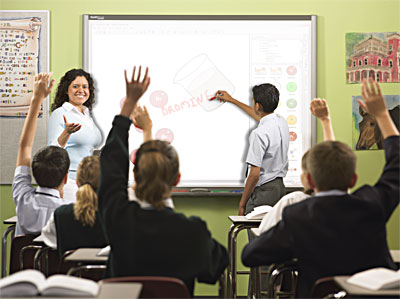Interactive Whiteboards in the Classroom

Imagine that you are a child sitting at your desk in a classroom waiting to start the day…
The teacher walks in, presses a button, and all of a sudden you and your classmates are teleconferencing with another classroom across the world in China for your social studies lesson. When you move on to math, the teacher displays multiplication tables on the same board and you and your classmates go up to the front of the room and take turns dragging and dropping the correct answers. The English lesson is exciting, too, because you get to read a book along with your class on the board, complete with pictures, right from your desk. At the end of the day, your teacher emails an absent classmate an audiovisual recording of everything that happened on the board that day, so even he doesn’t miss out.
Until recently, this kind of scenario seemed positively futuristic. With the incredible technology of interactive whiteboards (IWBs), it looks like the future is here.
For the past 20 years, interactive whiteboards have made their way into classrooms across the globe. In many K-12 schools, the traditional blackboard has been phased out entirely by the IWB because of the latter’s innovative flexibility.
Structurally, your general IWB is a large screen placed at the front of a classroom (or boardroom.) Many have desktop or tablet hubs from which the instructor writes on and navigates across programs and the web for students to see.
The uses and benefits of interactive whiteboards in the classroom are many:
-Presentations
-Ability to record information and lessons for those not in class
-Digital Storytelling -Teaching the fundamentals of Internet navigation in real time
-Demonstrating the correct usage of editing marks on typed text for the whole class to see.
Perhaps the most important contribution of interactive whiteboards to education is how readily they appeal to diverse learning styles in the classroom. For instance, in a classroom with a traditional blackboard, an audio learner is likely to be less intellectually stimulated than a student who is visual or tactile. An interactive whiteboard allows the teacher to integrate sound bytes in the form of music and video clips to instruct the audio learner more effectively and with ease. The interactive whiteboard is especially helpful to tactile learners because it gives them the ability to drag, drop, draw, and erase more clearly and decisively than they might on a blackboard.
We can’t underestimate the value of this technology in the classroom for a generation of students that is readily responsive to the Internet, touch screens, and everything digital. Interactive whiteboards meet children where they are cognitively, and they afford teachers a seemingly endless horizon of creative possibilities.
BCS is a first class proprietor of interactive whiteboards and we can answer any questions you may have about choosing, installing, and using an IWB in your classroom or office. Call us today.
image source: www.edudemic.com
source: http://www.rmtc.fsdb.k12.fl.us

